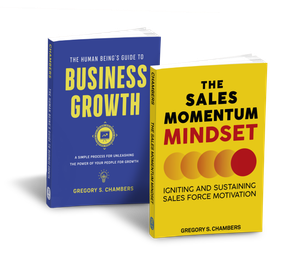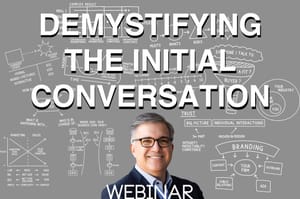LinkedIn, Sales Prospecting and Being Open to A Better Future
LinkedIn, Sales Prospecting and Being Open to a Better Future

This week I was planning on covering two inter-related issues: loyalty to your providers and keeping up with changes in thinking that may help your business thrive in the future. It sat in my drafts for a few days and then I received a LinkedIn invitation from someone that I didn't know.

He works at a life insurance company. I thought "Hey! This will be a live example of keeping an open mind yet staying loyal" and in this case it would be a new idea from a new contact. I would contrast that with the years of history with my other contacts. Then I received the follow up note. It was a standard "we should chat" note that used to come via phone call, then email, and now LinkedIn.
I couldn't do it. The note violated one of my core sales beliefs: what's in it for the customer? That may be harsh. It did reference the meeting being "not cost" to me and promised to "open my eyes to a better future." but those are two intangibles that are hard to quantify in a short email.
So instead of a sneak peek into how I weigh new ideas, I'm going to turn this from a client focus to a sales representative/business development focus. Why? Because it may be that introducing competitive ideas has less to do with a prospect's openness and more to do with how they're approached. I'll use this case from LinkedIn.
Here is what we'll cover:
- The Goal
- The Approach
- The Follow Up
- The Payoff
The Goal
Before we begin any endeavor, we need to ask ourselves what we want to get out of it. I'm going to put myself into this gentleman's shoes and say that my goal is to develop good contacts outside of my organic contact list. Moving beyond friends and family to get to business owners. That's a vague target, but with a few more questions about the target market like "any business owner?"; "any sized business?" "what do you mean by 'good contacts'?" a clearer picture would emerge. Something like "businesses under 5 employees that are likely to double in size over the next 7 years." Or "solo-practitioner businesses that have been in business for over 1 year." And "a good contact is someone that knows my name and services that I can keep in touch with over time."
Why is this important? 3 reasons: It helps you ask the right questions when confronted with a giant list of prospects, it helps you focus the message when you approach your prospects and it helps you accelerate your prospecting learning curve.
At this point, take a measure of where you are today and set two measures for where you want to be at a future point in time. A desired target and my minimum acceptable target. (for a discussion of minimum acceptable targets, go here) I take a quick census of my current contacts and find that I have 3 people that meet my criteria right now. By this time next year, I want 30 of them in my list. At the very least I want 10.
With the goal in mind, let's talk about using LinkedIn to approach.
The Approach
When you have narrowed your list, it's pretty easy to use LinkedIn as a tool. You can search by Title and Geography as well as 1st, 2nd and 3rd level connections. With the premium LinkedIn product, you can add in employee size and job function. That gives you a list and LinkedIn lets you put together a quick "I'd like to connect with you on LinkedIn" email.
Don't do it.
Instead, let's take a step back and look at the goal again. Up to this point we've been focusing on what you'd like as the sales person. Before we start sending notes or making calls, we need to figure out why anyone on our new list would want to talk to us. That makes sense, right? You've been on the other side of those calls and emails and the first thing you think is "Who is this guy?" Then your mind drifts to "What does he want?"
Let's use that internal monologue to our advantage. Because while he's wondering why you're calling, you should be wondering if he's going to meet the criteria that you outlined in your goal. Like, are they the owner and is their business growing? (to use example #1 above)
If you're in the business of giving advice, this is where you can bring some value to the name on the list and get an indication whether or not they should be on your list in the future. I call it "advice that my ideal customer would find interesting" and that's all it is. It's not "the exact right solution for this prospect" or some vague list of do's and don'ts that they have to jump through hoops for. It's something that answers the question "who is this guy and what does he want?" with advice that would be valuable to my target audience.
The invite on LinkedIn should be customized. Sometimes a simple "I see by your profile that we have some things in common. Let's connect because we might be able to help each other in the future." can go a long way (if you mean it). Don't hammer them with a message and don't be vague about your intentions. If they don't want to connect they aren't a prospect right now.
And that's the point, right? Not everyone is in the market at the exact time you contact them. Some people are and it's better to be lucky than good, but treat others the way you want to be treated as you work through the marketplace. Once they respond to your entreaty, it's time to follow up.
The Follow Up
I'm assuming this person you have a loose connection with has decided to give you a sliver of hope and accepted your invitation to connect, so it's time to give them some value. This is where you offer up your "advice that my ideal customer would find interesting." It can be in a report, a long email, a link to a short video or whatever else you dream up. There is no trick to it per se, but if it's not truly advice that your ideal customer would find interesting, it won't work.
My life insurance salesperson jumped right in with an appointment request that offered me a vision of a better future. That may have been a finely crafted test message that released me from follow up, but chances are it was an actual solicitation. With my approach he would have offered some advice that offered evidence of a better future. With our example of "owner" and "growing business" it might look like this:
"Greg, thanks for connecting with me. I don't know how or when, but someday that little gesture will pay off. In the meantime, I have a small report that my clients find valuable. It 's a high level overview of 5 mistakes that owners of fast growing businesses make when scaling their firms. If that sounds interesting to you, I can send it over. Happy Monday!"
It reinforces your original query suggesting that someday you might help one another, it asks for nothing in return for some information and it is polite enough to acknowledge that a "no" answer is as valid as a "yes" answer.
If they respond asking for the report, you have what we'd call an Early Stage Qualified Lead or Marketing Lead, or whatever you want to title your lead list that you will keep in touch with over time. Now that you know that the person on the other end is open to your ideas, you're ready for the next step.
The Payoff
Once the report has been delivered, you have permission to follow up in order to get feedback. This isn't permission to press for an appointment or permission to bid on a project. You should genuinely be looking for feedback on the report. Was it helpful? Was it insightful? Did it provoke any thoughts?
The response or lack of response should give you some indication of where this person stands in the grand scheme of thinking about the problems you solve. Think of the entire population of your prospects as existing on a scale of 1-10 with 1 being "never will" and 10 being "ready today". Your goal is to spend time with the 8, 9's and 10's. Set up systems to help you manage the 1's through 7's.
Wondering what the ratios look like at each step?
Within a recent project we tried a test making new connections inside of a series of large medical device companies. 172 identified contacts inside LinkedIn, initial invites sent at a rate of 20 a week over two months. 103 new contacts accepted, 37 requests for our report and 3 extended conversations. After months of newsletters I can see 90% of those names have stayed on and 40% of them have clicked through the content.
Is that impressive? On the surface it doesn't look like much, but in the greater mix of our effort to take market share from competitors, it has promise.
(on a side note, during the approach we also updated our LinkedIn profile. This led to being included in one of those "Congratulate Jim on His New Position!" emails from LinkedIn . . . and that led to being included on a new RFP from a dormant lead. As I've said, it's better to be lucky than good.)
Conclusion
I saw a quote last week that said something like "the communication tools that we use are constantly changing, but the way the brain makes decisions stays the same." That's how we need to approach any new tool that our target market is using. Map the use of the tool to what we know about how new ideas are adopted or how we consider new suppliers. Move through the prospect's decision making process at their pace. Help them make a good decision.
Stick to the process.
Good stuff.




